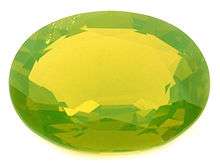chrysoberyl
See also: chrysobéryl
English
Etymology

Chrysoberyl
From Latin chrysoberyllus, from Ancient Greek χρῡσοβήρυλλος (khrūsobḗrullos), from χρυσός (khrusós, “gold”), after its color, and βήρυλλος (bḗrullos, “beryl”).
Pronunciation
- (UK) IPA(key): /ˈkɹɪsə(ʊ)bɛɹɪl/
Noun
chrysoberyl (countable and uncountable, plural chrysoberyls)
- (mineralogy) A vitreous mineral, often pale green, a mixed oxide of aluminium and beryllium with the chemical formula BeAl2O4, used as a gemstone.
- 2012 March 1, Lee A. Groat, “Gemstones”, in American Scientist, volume 100, number 2, page 128:
- Although there are dozens of different types of gems, among the best known and most important are diamond, ruby and sapphire, emerald and other gem forms of the mineral beryl, chrysoberyl, tanzanite, tsavorite, topaz and jade.
-
Translations
mineral
|
|
Further reading
- “Chrysoberyl” in David Barthelmy, Webmineral Mineralogy Database, 1997–.
- “chrysoberyl”, in Mindat.org, Hudson Institute of Mineralogy, accessed 29 August 2016.
- James D. Dana: Dana's System of Mineralogy. Volume I, seventh edition, revised by Charles Palache, Harry Berman, and Clifford Frondel. John Wiley & Sons, 1944
This article is issued from
Wiktionary.
The text is licensed under Creative
Commons - Attribution - Sharealike.
Additional terms may apply for the media files.